Identifying the Pyramid and Power of Inbound Marketing: Attracting Your Ideal Customers
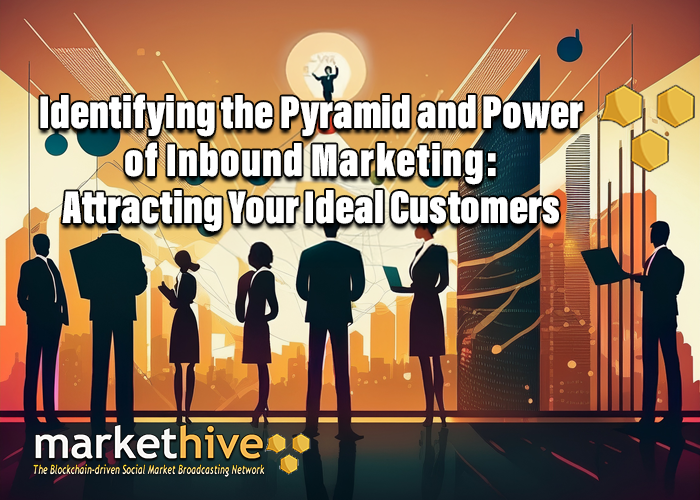
In today's hyper-connected and increasingly competitive business environment, the way companies connect with their target audience has undergone significant changes. While traditional outbound marketing, characterized by its "push" approach, which broadcasts messages through methods such as cold calls, television ads, or direct mail, still plays a role in some strategies, a more effective, customer-focused, and growing alternative has proven to be highly successful in customer acquisition in B2B and B2C markets – Inbound Marketing.
Inbound marketing is a strategic method that aims to attract prospects to your website and brand by providing valuable, relevant content and experiences carefully tailored to their specific needs and interests. Inbound Marketing operates on the principle of permission marketing, where potential customers are drawn in by helpful and relevant information, organically leading them through their buyer's journey.
This methodology fosters trust and credibility, positioning businesses as thought leaders and problem solvers in their respective industries. The long-term benefits include not only increased customer acquisition but also enhanced customer loyalty, improved brand perception, and more efficient marketing spend due to better targeting and higher conversion rates.
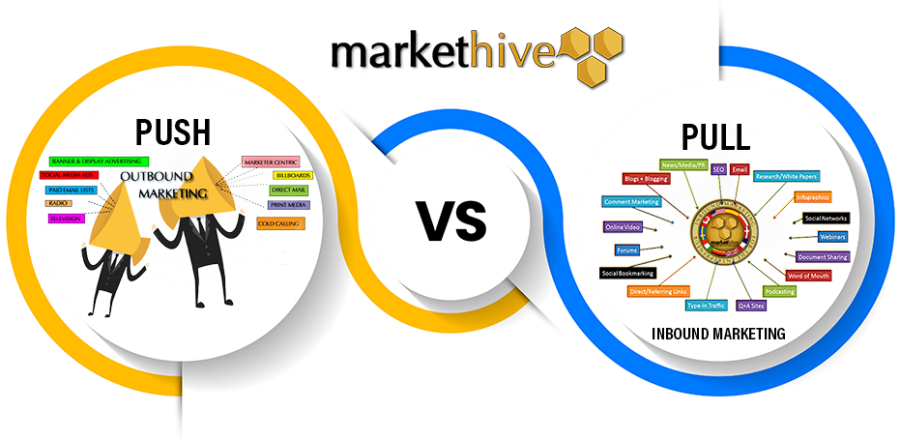
The Fundamental Difference: Inbound vs. Outbound – A Paradigm Shift
The distinction between inbound and outbound marketing is not merely semantic; it represents a clear and profoundly impactful difference in philosophy and approach:
- Outbound Marketing: The "Push" Approach: This traditional approach involves bringing your offering to your prospects, often through methods that can feel intrusive or unsolicited. Examples include cold calling, conventional advertising (such as television, radio, and print media), direct mail campaigns, and trade shows. It's frequently perceived as a more aggressive, "pushy," and often one-way communication style.
- Inbound Marketing: The "Pull" Approach: In stark contrast, inbound marketing is about bringing your prospects to you. It's a deliberate strategy focused on attracting them organically through the provision of valuable content and genuinely helpful resources, allowing them to discover your brand and offerings on their own terms, at their own pace. It respects the customer's journey and empowers them to seek information.
Striking the Perfect Balance: Inbound and Outbound Marketing at Markethive
At Markethive, we advocate for a sophisticated marketing strategy that centers around an inbound approach, thoughtfully integrated with strategic outbound tactics. This philosophy recognizes the evolving landscape of consumer behavior, where genuine engagement and value-driven interactions are paramount. While the core of our methodology is inbound-focused, we recognize the critical role that outbound marketing plays in broadening our reach and initiating initial contact with potential buyers.
Leveraging Outbound for Initial Reach:
Our outbound strategy leverages powerful channels, including the Banner Program. This program allows our members to purchase banner impressions through the Banner Impressions Exchange, a dynamic marketplace designed to maximize visibility. These strategically placed banners are displayed both internally within the Markethive ecosystem and externally across a vast network of domains.
This dual-pronged approach ensures that your business gains significant exposure, effectively getting your brand and offerings in front of a diverse and relevant audience of potential buyers. The purpose of this initial outbound push is not to sell directly, but to generate awareness and pique interest, setting the stage for a more nuanced engagement.
The Power of Inbound for Nurturing and Conversion:
Once initial contact is made through outbound efforts, Markethive's comprehensive suite of inbound tools takes center stage. Here, the focus shifts dramatically from direct selling to assisting with the buyer's journey. This is where our philosophy truly shines. Instead of immediately asking for a sale, we empower you to provide valuable content, insights, and solutions that guide potential customers through their decision-making process.
This inbound-centric approach is highly effective because it aligns with modern consumer preferences. People are inherently more likely to engage with and ultimately commit to a brand that demonstrates a genuine desire to help them understand their needs, explore options, and navigate the buying process. By offering educational resources, insightful articles, interactive tools, and personalized support, you build trust, establish credibility, and position yourself as a valuable resource rather than just a salesperson. This fosters a relationship based on mutual understanding and value, dramatically increasing the likelihood of conversion.
The Synergy of Inbound and Outbound:
The true strength of the Markethive approach comes from the synergy between inbound and outbound marketing. Outbound strategies serve as the starting point, attracting a broad audience to your business. Inbound then takes the lead, converting these initial contacts into engaged leads by offering the information and support they need to make informed choices.
This combined approach ensures a steady flow of potential customers, guiding them smoothly from awareness to loyal advocacy. By effectively balancing these two strategies, Markethive enables its members to build sustainable businesses, foster strong customer relationships, and achieve long-term success in the competitive digital landscape.
Key Components of a Comprehensive Inbound Marketing Strategy: A Synergistic Ecosystem
A truly comprehensive and effective inbound marketing strategy is not a singular tactic but rather a sophisticated integration of various digital marketing tactics. These components are designed to work synergistically, creating a seamless and holistic customer journey that aims to achieve the ultimate goal of attracting, engaging, and converting customers into loyal advocates. These critical components often include:
- Content Creation (Blogging, E-books, Video, and Beyond): This is the foundation of inbound marketing. Consistently generating high-quality, informative, and engaging content is vital for attracting and educating your audience. It encompasses various formats, including insightful blog posts, detailed articles, attractive infographics, authoritative white papers, comprehensive e-books, engaging videos, podcasts, and interactive tools. This content should be carefully designed to address common customer questions, resolve their pain points, and provide practical, relevant solutions that align with your target market's needs. The goal is to showcase expertise and deliver real value before making any sales pitches.
- Email Marketing: Nurturing Relationships and Guiding the Journey: Once a prospect shows initial interest, such as downloading an e-book or subscribing to a newsletter, email marketing becomes a crucial tool for building that early relationship. Through targeted email campaigns, businesses can continue to send valuable content, share relevant updates, introduce new products or services, and gently guide prospects through the various stages of the buyer's journey, ultimately turning them from curious visitors into engaged leads and satisfied customers.
- Marketing Automation: Streamlining Efficiency and Personalizing Engagement: This advanced technology aims to simplify and automate repetitive marketing tasks, freeing up valuable personnel and ensuring consistent, timely communication. It includes automated email dispatches based on user actions, scheduled social media posts, and complex lead nurturing workflows that provide personalized content to prospects at the optimal moment in their decision-making journey, regardless of their position in the sales funnel. Automation guarantees that no lead is overlooked and that communication remains relevant.
- Social Media Monitoring & Publishing: Building Community and Amplifying Reach: Engaging actively with your audience on key social media platforms is crucial for enhancing brand awareness, fostering a sense of community, and driving meaningful traffic to your website. Besides sharing engaging content, keeping track of social media discussions offers crucial real-time insights into customer opinions, new industry trends, competitor actions, and opportunities for direct engagement and customer support. Social media is a two-way channel for building connections.
- Search Engine Optimization (SEO): Ensuring Discoverability and Visibility: Optimizing your website and all your content for major search engines is crucial for ensuring that your target audience can easily find you when they are actively searching for information, products, or services related to your offerings. This involves a comprehensive approach, which includes conducting detailed keyword research to identify relevant terms, building high-quality, authoritative backlinks from reputable websites, maintaining a technically sound and fast-loading website, and continually optimizing content to align with user intent. Effective SEO makes your "magnet" visible to those already searching for what you provide.
- Analytics and ROI Measurement: Data-Driven Optimization: Being able to track the performance of your inbound marketing efforts is crucial for understanding what's truly effective, what can be improved, and where to allocate resources best. Strong analytics tools provide detailed insights into key metrics, including website traffic sources, lead generation numbers, conversion rates at each stage, user behavior patterns, and, importantly, the exact return on investment (ROI) of your marketing activities. This data-driven feedback loop enables ongoing refinement and optimization of strategies, ensuring maximum effectiveness and efficiency.
- Landing Pages: Capturing Leads with Purpose: These are highly focused, standalone web pages carefully created with a single goal: to collect lead information, such as name and email address, in exchange for a valuable offer, such as an e-book, a webinar registration, a free trial, or a Promo Code. Landing pages are crucial tools for conversion, transforming anonymous website visitors into identifiable leads that can be further nurtured and developed.
- Content Management System (CMS): The Organizational Backbone: A robust Content Management System (CMS) is indispensable for efficiently organizing, publishing, and optimizing all your content assets. It simplifies the process of managing your entire inbound marketing ecosystem, from blog posts and landing pages to email templates and calls-to-action, ensuring consistency and ease of updates.
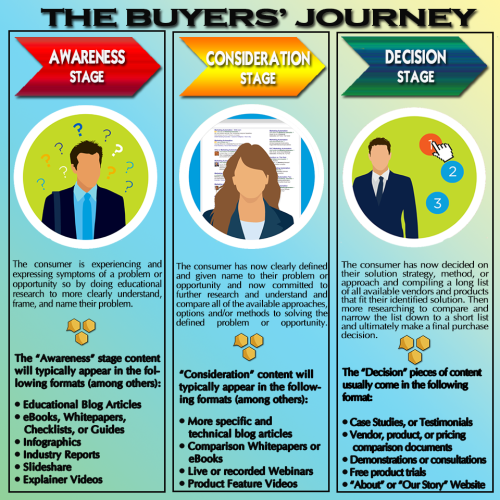
The Evolving Landscape of the Buyer's Journey
The Buyer's Journey, a key concept in marketing, has undergone significant evolution since its introduction in 1968. What was once considered a simple, step-by-step process has become complex and multi-layered, mainly due to the rise and widespread influence of the internet. Today's consumers are more empowered and informed, with unparalleled access to information, which necessitates a customer-focused approach to inbound marketing.
The traditional model of the Buyer's Journey outlined a series of clear, step-by-step stages a customer would go through from initial awareness to making a final purchase. However, in today's digital age, these stages have become less distinct, making the journey more flexible and adaptable. Consumers no longer passively absorb information; instead, they actively seek it out, researching products and services, comparing options, and engaging with brands on their own terms. This shift requires businesses to adjust their strategies to provide consistent, relevant, and valuable content at every stage of the customer journey.
The Online Arena: A Golden Opportunity for Inbound Marketers
The modern Buyer's Journey mostly happens online. This presents an excellent opportunity for inbound marketers to go beyond traditional advertising and genuinely support potential buyers throughout their decision-making process. By creating custom content that addresses specific needs and challenges at each stage, businesses can attract, engage, and ultimately meet the needs of their target audience. This approach not only builds trust but also positions the company as a credible and helpful resource.
The Three Pillars of the Inbound Buyer's Journey
Despite the increased complexity, the core stages of the Inbound Buyer's Journey remain foundational:
- Awareness Stage: During this initial phase, the buyer recognizes a problem or need but may not fully understand its nature or extent. Their online research aims to identify the problem, understand its implications, and gather basic information. This stage involves searching for answers, educational resources, research data, expert opinions, and insightful content that help define their challenge. Content at this stage should be informative, focused on solving problems, and not overly promotional. Examples include blog posts addressing common pain points, informational guides, and industry reports.
- Consideration Stage: After the buyer clearly identifies their problem, they enter the consideration stage. During this phase, their research becomes more detailed and focused. They actively seek specific solutions to their problems and compare various options available on the market. This involves evaluating the features and benefits of multiple products or services to determine the best fit for their specific needs. At this stage, buyers seek detailed information, case studies, product comparisons, and testimonials to understand the advantages and disadvantages of various approaches. They also begin to identify potential solution providers, partners, or vendors.
- Decision Stage: After thorough research and evaluation, the buyer reaches the decision point. They have consumed enough expert and trust-building content to shortlist potential providers. At this crucial moment, they are ready to confidently choose with whom to work or from whom to purchase. The content here should be compelling, offering clear reasons why a specific solution is the best choice. This includes product demos, free trials, consultations, success stories, and strong calls to action. The aim is to give all the needed information and reassurance for the buyer to finalize their commitment.
Inbound marketing is strategically aligned with the Buyer's Journey. Its main goal is to help prospects naturally discover a business during the early stages of their journey. By offering valuable content that educates them on the benefits of a specific solution, inbound marketing builds trust throughout the entire process. This ongoing cultivation of trust, from initial awareness to final decision, is essential in turning a curious prospect into a loyal customer. It's about being a helpful guide rather than a pushy salesperson, empowering the buyer to make informed decisions at their own pace.
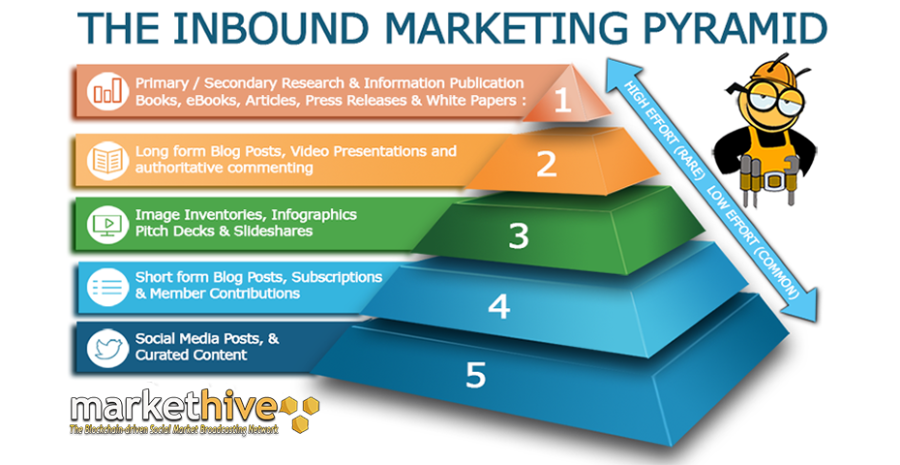
The Inbound Marketing Pyramid
The Inbound Marketing Pyramid is a strategic framework that outlines the different levels of content creation and distribution, moving from foundational, in-depth resources to more frequent, bite-sized interactions. Each level builds upon the previous one, aiming to attract, engage, and delight potential customers by providing valuable information at various stages of their buyer's journey.
Here's a more detailed look at each level:
1: Primary/Secondary Research and Information Publication: Books, eBooks, Articles, Press Releases, and White Papers.
The top level represents the most authoritative and in-depth content. It's where you establish your expertise and thought leadership. This content is typically the result of extensive research, data analysis, and original insights.
- Books and eBooks: Offer comprehensive dives into a subject, providing extensive knowledge and a holistic understanding. They position your organization as a go-to authority.
- Articles (Long-Form and Academic): While still in-depth, these can be more focused on specific topics within your broader expertise. They often present research findings, new methodologies, or detailed case studies.
- Press Releases: Announce significant news, product launches, or company milestones to generate media attention and build credibility.
- White Papers: These are persuasive, in-depth reports on a specific problem and its solution. They are designed to educate and inform potential customers, often serving as lead generation tools.
2: Long-Form Blog Posts, Video Presentations, and Authoritative Commenting.
This level focuses on breaking down foundational knowledge into more accessible yet still substantial formats. This content aims to engage audiences who are actively seeking solutions or a deeper understanding.
- Long-Form Blog Posts: These are detailed explorations of specific topics, typically ranging from 1,000 to 3,000 words or more. They provide valuable insights, answer common questions, and demonstrate practical applications of your expertise. They are crucial for SEO and driving organic traffic.
- Video Presentations (Webinars, Tutorials): Video is a highly engaging medium for conveying complex information. Webinars enable live interaction and Q&A, while tutorials provide step-by-step guidance. They cater to visual and auditory learners and can significantly boost engagement.
- Authoritative Commenting: Engaging in thoughtful, insightful discussions on industry blogs, forums, and social media platforms can establish your presence as an expert and drive traffic back to your own content. It demonstrates active participation in your field.
3: Image Inventories, Infographics, Pitch Decks, and Slide Shares.
This level emphasizes visual content, which is highly effective for conveying information quickly and memorably. Visuals enhance engagement and make complex data more digestible.
Image Inventories: A collection of high-quality, relevant images that can be used across all content types. A consistent visual style reinforces brand identity.
- Infographics: Highly shareable visual representations of data, statistics, or complex processes. They simplify information and make it more appealing, often going viral on social media.
- Pitch Decks: Professional presentations, often used for sales or investor meetings, that succinctly convey key information and value propositions. They can be shared publicly (with appropriate modifications) to educate and attract new audiences.
- SlideShares: Uploading presentations (such as pitch decks or webinar slides) to platforms like SlideShare expands their reach and makes them discoverable to a broader audience.
4: Short-Form Blog Posts, Subscriptions, and Member Contributions.
At this stage, the focus shifts to more frequent and accessible content that keeps your audience engaged and nurtures relationships.
- Short-Form Blog Posts: These are quick, digestible updates, news items, or opinion pieces, typically under 1,000 words. They maintain a consistent content flow and address timely topics, encouraging regular visits to your site.
- Subscriptions (Email Newsletters): Building an email list through subscriptions allows for direct communication with your audience. Newsletters can deliver curated content, exclusive insights, and updates, fostering a loyal community.
- Member Contributions (Guest Posts, Community Forums): Encouraging contributions from community members, either through guest blogging or active participation in forums, builds a sense of community and provides fresh perspectives. This also leverages user-generated content.
5: Social Media Posts and Curated Content.
The bottom of the pyramid represents the most frequent and immediate interactions. This level focuses on achieving a broad reach, fostering quick engagement, and driving traffic back to your more in-depth content.
- Social Media Posts: Short, engaging updates designed for platforms like Facebook, X, LinkedIn, and Instagram. These can include links to your longer content, quick tips, industry news, and calls to action. The goal is to capture attention and direct users to more in-depth resources.
- Curated Content: Sharing relevant and valuable content from other industry leaders or reputable sources. This not only provides value to your audience but also positions you as a helpful resource, fostering relationships with other thought leaders. It demonstrates that you're well-informed and connected within your industry.
By strategically developing and distributing content at each level of the Inbound Marketing Pyramid, businesses can effectively attract, engage, and convert their target audience, ultimately building brand authority and driving sustainable growth.
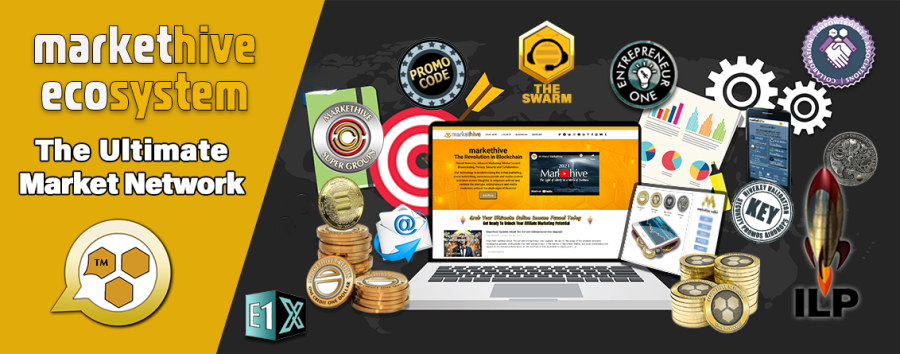
Markethive: The Next-Gen Market Network
Markethive leads the inbound marketing revolution with over 25 years of experience. This long history allows it to evolve continuously, adapting to the ever-changing marketing landscape. What truly sets Markethive apart is its proactive use of cutting-edge Blockchain technology and cryptocurrency. This innovative approach positions Markethive as a leader, particularly when many traditional marketing platforms continue to rely on outdated methods.
At its core, Markethive delivers a robust and proven inbound marketing platform designed to empower entrepreneurs and businesses of all sizes. The platform offers a comprehensive suite of tools meticulously crafted to guide individuals through the buyer's journey, from initial awareness to becoming loyal customers. These essential functionalities include:
- Email Autoresponders: Automate and personalize email campaigns to nurture leads and build strong customer relationships.
- Blogging Platforms: Create and publish engaging content to attract organic traffic and establish thought leadership.
- Content Management Service: Efficiently organize, manage, and optimize all digital content for maximum impact.
- Landing Pages: Design high-converting landing pages to capture leads and drive specific actions.
- Social Media Broadcasting: Seamlessly distribute content across various social media channels to expand reach and engagement.
- Tracking Analytics: Gain valuable insights into campaign performance, user behavior, and overall marketing effectiveness.
- SEO (Search Engine Optimization): Optimize content and website for higher search engine rankings, increasing visibility and organic traffic.
- Backlink Automation: Automate the process of acquiring high-quality backlinks to enhance SEO efforts further.
- Messaging: Facilitate direct and personalized communication with prospects and customers.
- E-commerce: Integrate robust e-commerce solutions to facilitate online sales and transactions.
The collective benefit of these integrated systems is to seamlessly "attract" potential customers, "convert" them into leads, "close" sales opportunities, and ultimately "delight" them, fostering a loyal and long-term customer base.
Beyond Marketing: A Collaborative Community and Income-Generating Ecosystem
Markethive transcends the traditional definition of a marketing platform. It is a next-generation ecosystem that fosters a vibrant community of aspiring entrepreneurs and marketers. This is achieved through:
- Multiple Commerce Platforms/Supergroups: Providing diverse avenues for conducting business and generating revenue.
- Digital Media Sites: Offering various channels for content dissemination and community engagement.
- Social Network: A dedicated social network that brings together like-minded individuals, encouraging a collaborative mindset and shared growth.
Perhaps the most revolutionary aspect of Markethive, and a testament to its forward-thinking vision, is its focus on providing income-generating opportunities for all members. Built on the secure and transparent foundation of blockchain, Markethive is uniquely positioned to reward members, via micropayments, bounties and faucets for all their activity within the platform, and directly allocated to the member's Markethive wallet. This applies whether a member is using the free services or has upgraded to one of the loyalty programs or memberships. This innovative approach reflects Markethive's core belief in sharing resources to empower its community.
Vision of Shared Success
Markethive's philosophy is based on the belief that sharing resources and helping individuals grow their businesses and reach their goals benefits everyone. This spirit of collaboration is reflected in their welcoming message: “We welcome all to our collaborative world and ecosystem for the Entrepreneur, Markethive, the Market Network, built for you, by you, and with you.” It's a testament to a platform designed not just to serve, but to empower, creating a mutually beneficial environment where collective success is the ultimate aim.
.png)

Tim Moseley
